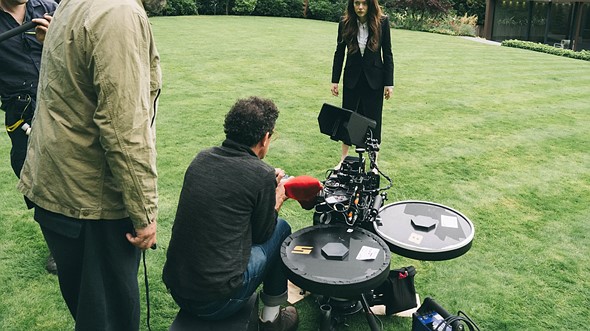
| A VistaVision camera on the set of Bugonia. Image: Variety / Focus Features |
What are you willing to put up with to get the exact aesthetic you’re looking for? For some Hollywood directors like Yorgos Lanthimos or Paul Thomas Anderson, the answer is a lot, at least according to The Wall Street Journal. The publication recently put out a story titled “The Biggest Diva in Hollywood Is a Camera,” going over the on-set headaches brought on by using old VistaVision cameras on productions like Bugonia and One Battle After Another.
The issues are numerous: film jams and other “moody” behaviors that occasionally required some percusive maintenance to fix, and the racket that comes with running 35mm film horizontally, rather than vertically, through the camera. The article recounts ruined takes, on-set slowdowns and the need for insulated boxes and special software to keep the sounds of the camera from ruining dialogue. Overall, it turns out that using cameras whose heyday was in the 50s can be a bit of a pain.
Presumably, those issues didn’t come as a surprise to the directors
Well… duh. I could’ve told you that, and I don’t even have an IMDB page (yet). Presumably, those issues didn’t come as a surprise to the directors and cinematographers who have chosen to work with them either. (Though the actors may be a different story.) So why did they choose to do it?
I’m sure part of it had to do with the experience. As with shooting stills, there’s a texture to shooting movies with film that would take a lot of work and discipline to replicate with digital. To paraphrase Reed Morano in Side By Side*, people may take things a bit more seriously when they hear the money running through the camera, kind of like how photographers are more considered with their compositions when they only have 36 exposures.
Of course, you can get that experience using more modern film cameras that won’t have so many issues. The WSJ goes a bit into why the artists chose VistaVision specifically, and cites a variety of reasons, with the foremost being the look. Shooting a movie on what is essentially a stills photography format gets you more detail than you’d typically be able to achieve with a 35mm movie camera, while still having the look of film.
The result is an aesthetic that’s somewhat familiar, but grandiose, a callback to tentpole films like North by Northwest and The Searchers. Sure, there are modern digital cameras from Red and Panavision with similarly large sensors, but do they have the heritage?
Maybe not, though I am left wondering whether the audience will truly notice the difference. Certainly, those watching the movie on their phones during their commute or their uncalibrated TVs sitting right in front of a window won’t, but there’s also the argument to be made that we shouldn’t make art for the lowest common denominator viewing experience. And realistically, if you want that specific aesthetic, you either have to go with old film cameras, spend a lot of time in post, bending digital footage to make it look like film, or shoot Imax. And the latter has a lot of the same problems unless, of course, you’re Christopher Nolan and can just get Imax to make you an updated camera**.
The Wall Street Journal article is well worth a read, even though most people who have touched a camera before will likely be unsurprised by the initial premise. It’s still an interesting look at the lengths some artists will go to fully realize their vision, and the eccentricities of the movie business and old tech.
I’d be interested in hearing from you, though. Do you often find yourself putting up with an annoying camera purely because of the look it produces? Do you find the look of VistaVision or other large film formats compelling enough that you totally get it? Are you happy to have left film behind forever? Let us know over on our forums.
* A documentary hosted by Keanu Reeves interviewing a who’s who of cinematographers and directors about digital cinematography, which you should definitely watch if you’ve made it this far into this article.
** And if you are Christopher Nolan: Hi. Big fan. Don’t listen to the haters, I thought Tenet was pretty good.
